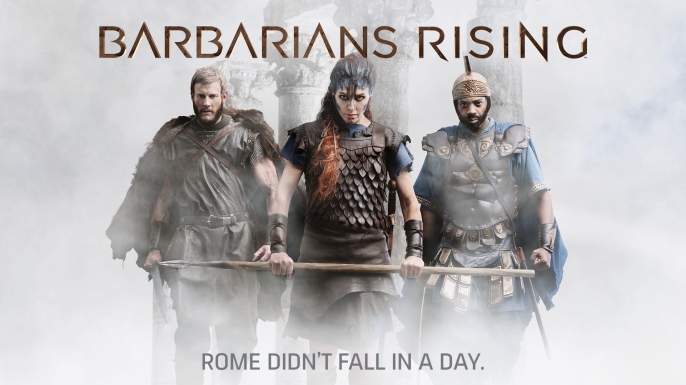
Rome Falls
The sack of Rome in 455 by the Vandals signaled the collapse of the Roman Empire.From the third to the fifth century A.D. various foreign armies—chief among them the Goths,
Vandals and Huns—began making serious inroads into Roman-held territory.
Branded by the Romans as brutish, violent and uncivilized, these “barbarian”
groups proved to be formidable opponents on the field of battle,
applying relentless pressure that would eventually topple the Western Roman Empire.
Find out more about eight of the most famous barbarian leaders, including their origins,
their military exploits and the kingdoms many of them established during the late Roman period and beyond.

Arminius
Born into a noble family of the Germanic Cherusci tribe around 18 B.C.,Arminius (known in Germany as Hermann) was plucked from his home by the Romans as a boy
and served in the Roman army. In 9 A.D., his Cherusci forces ambushed and massacred three Roman legions
under Publius Quinctilius Varus, governor of the province of Germania, in Teutoburg Forest.
In the wake of the humiliating defeat—after which a crushed Varus fell on his own sword—the Romans withdrew behind the Rhine,
and did not attempt any further invasions.
Though Arminius would be hailed as a nationalist hero during the unification of Germany in the late 19th century,
his reputation suffered in the wake of World War II,
when modern Germans associated his historic exploits with the militant nationalism of Adolf Hitler’s Third Reich.

Boudica
Like other Celtic women, Boudica (or Boadicea) enjoyed greater liberty than many other women in the ancient world,and trained in fighting and weapons alongside the men of her tribe. When her husband,
King Prasutagas of the Iceni people of East Anglia (present-day eastern England),
died with no male heir in 60 A.D., the Romans took the opportunity to annex his kingdom,
publicly flog Boudica and rape her two daughters. With the Roman provincial
governor Gaius Suetonius Paulinus absent from the region, the defiant warrior queen led a rebellion
of disgruntled Iceni and other tribes to victory over the Roman Ninth Legion.
According to the Roman historian Tacitus, Boudica’s forces massacred some 70,000 Romans
and pro-Roman Britons in their rampage. Paulinus soon returned,
and his forces won a standoff at an unknown site. In the wake of that defeat,
Boudica likely killed herself with poison.

Alaric
One of the most famous barbarian leaders,the Goth King Alaric I rose to power after the death of the Eastern Roman Emperor Theodosius II in 395 A.D.
shattered a fragile peace between Rome and the Goths.
When the Western Emperor Flavius Honorius refused to supply Alaric’s forces with land and supplies in 408,
Goth forces laid siege to Rome. In the summer of 410, a group of rebellious slaves opened the Salarian Gate,
and Alaric’s troops became the first foreign enemy to enter the city in some 800 years.
They plundered Rome over three days, but treated its inhabitants humanely.
Alaric is thought to have died soon after they left, during a subsequent expedition towards Africa.
His descendants, the Visigoths, migrated to Iberia and established their kingdom in what is now Spain.

Attila the Hun
Born into a royal family of Huns, a nomadic people based in what is now Hungary,Attila rose to power alongside his brother, Bleda, in 434 A.D.. A onetime ally of Rome against other barbarian groups,
including the Burgundians and Goths,
Attila accepted hefty subsidies in gold in exchange for not attacking Roman territory—then did it anyway.
After having Bleda killed, he assumed total control of an empire that stretched across Central Europe.
A complicated series of events involving Western Emperor Valentinian III and his sister,
Honoria, inspired Attila to invade Gaul (present-day France) in 450.
Though a combined force of Romans and Visigoths blocked the invasion, Attila was undaunted,
and in 452 he invaded Italy. The Romans sent Pope Leo I as a peace emissary,
and though the details of their meeting are unknown,
Attila subsequently withdrew his troops and returned to Hungary. In 453,
he was found dead the morning after his wedding (he had multiple wives),
apparently the victim of a fatal nosebleed, accidental alcohol poisoning or a murderous conspiracy,
possibly involving his new bride, Ildico.

Genseric
Soon after the Vandal king Genseric (also Geiseric or Gaiseric) rose to power in 428 A.D.,he led some 80,000 of his people to North Africa,
where they established a kingdom that would effectively control the Mediterranean Sea for the next century.
After Emperor Valentinian III was assassinated,
voiding a treaty that had promised his daughter, Eudocia, to Genseric’s son in marriage,
the Vandals marched on Rome in 455. Realizing the inadequacy of their defenses,
the Romans again sent Pope Leo I to plead for mercy.
Thanks to the pope’s diplomacy,
the Vandals agreed not to burn the city or massacre its inhabitants in exchange for free entry.
A victorious Genseric later returned to North Africa,
where he successfully crushed two Roman attacks (in 461 and 468) and raided the territories of the Eastern Empire from Alexandria,
Egypt to Anatolia. He died in 478 of natural causes, still undefeated on the field of battle.

Odoacer
Most scholars agree that Odoacer, the first barbarian king of Italy,was the son of Edico the Hun,
king of the Germanic Sciri tribe and advisor to the feared Hun leader Attila.
In 476 A.D., after serving as a commander in the Roman Army in Italy,
Odoacer led a rebellion against Orestes,
a Roman general who had overthrown Western Emperor Julius Nepos and had his teenage son,
Romulus Augustulus, declared as emperor.
Odoacer’s forces captured and executed Orestes and sent Romulus
Augustulus—the last Roman emperor in the West—into exile.
Though he officially recognized the sovereignty of the Byzantine emperor,
Zeno, Orestes refused to restore Julius Nepos as emperor in the West (as Zeno wanted),
instead declaring himself king. He was a tolerant ruler,
allowing the practice of Roman Catholicism despite his own Arian Christian faith. Eventually,
Zeno’s alliance with Ostrogoth (eastern Goth) leader Theodoric spelled the end for Odoacer’s reign,
as Ostrogoth forces invaded Italy in 489 and soon captured nearly the entire peninsula.
Odoacer managed to hold out for a while in Ravenna,
but after signing an agreement to govern the city jointly in 493,
Theodoric murdered Odoacer, his family and his followers.

Clovis
Clovis I was the first ruler of the so-called Merovingian dynasty,which would rule in Gaul and Germany from 500 to 750 A.D., and is considered the founder of France.
The son of Childeric, the pagan king of a Germanic tribe known as the Salian Franks,
Clovis assumed the throne in 481, when he was only 15 years old.
After defeating the last Roman governor of Gaul at the Battle of Soissons in 486,
Clovis established a united kingdom of various Frankish peoples stretching from the west bank of the Rhine to the Atlantic Ocean.
Clovis famously converted to Catholicism, and his kingdom blended Roman and Germanic cultural traditions.
A power struggle with the young Visigoth king Alaric II marked much of Clovis’ reign, but in 507
Clovis defeated and killed his rival near Poitiers, in west-central Gaul. From the seat of his empire in Paris,
Clovis sought to expand his empire further, but was thwarted in these attempts by Theodoric,
the powerful Ostrogoth ruler of Italy. Clovis died around 511,
and his Merovingian descendants (notably Charlemagne) would rule for more than 200 years;
no fewer than 18 future French kings would bear the name Louis, the Latinized version of Clovis.

Theodoric
As a boy, Theodoric was sent to Constantinople as a hostage of the Eastern Roman Empirein order to ensure the compliance of his father, the Ostrogothic chieftain Theodemir,
with a Roman-Goth treaty. Though he never learned to read or write,
he adopted many aspects of Roman culture. In 488 A.D.,
Theodoric invaded Italy, conquering virtually the entire peninsula and Sicily by 493,
when he manipulated and killed his rival, Odoacer.
By his own design, peace ruled in Italy throughout
Theodoric’s more than three decades (33 years) in power.
He issued edicts to ensure fair legal treatment for both Goths and Romans,
and stressed that the two groups should live together amicably.
Far from the brutish stereotype of a “barbarian” king,
Theodoric clothed himself in the royal purples favored by Rome’s emperors and worshiped the ideal of civilitas
(“civilized life” or “civilization”). After his death in 526, he would be remembered as
Theodoric the Great for his peaceful, fair governance and his revitalization of Italy after the fall of the Western Roman Empire.






